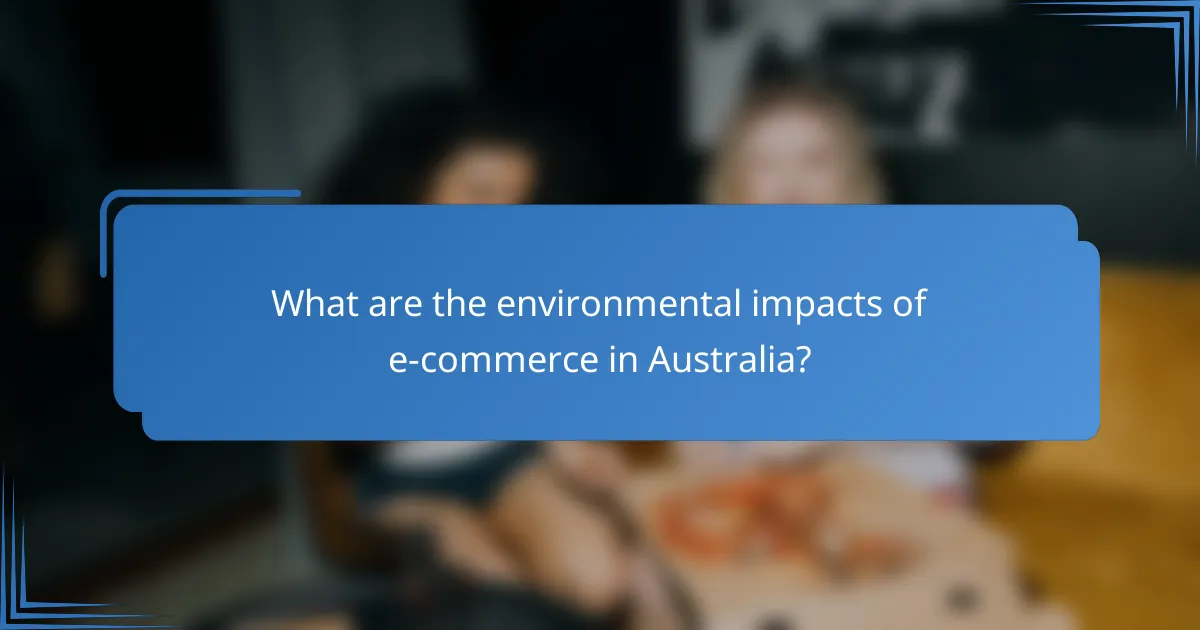In Australia, businesses can significantly improve sustainability outcomes by adopting eco-friendly practices that minimize environmental impact and engage community support. By leveraging renewable energy, embracing circular economy principles, and implementing sustainable packaging, companies not only contribute to environmental conservation but also resonate with eco-conscious consumers. Collaborative efforts within communities further amplify these initiatives, fostering a collective approach to sustainability that benefits both the environment and local stakeholders.

How can businesses in Australia improve sustainability outcomes?
Businesses in Australia can enhance sustainability outcomes by integrating eco-friendly practices, reducing environmental impact, and fostering community support. Key strategies include utilizing renewable energy, adopting circular economy principles, and participating in carbon offset initiatives.
Implementing renewable energy sources
Utilizing renewable energy sources, such as solar and wind, is crucial for businesses aiming to reduce their carbon footprint. In Australia, solar power is particularly accessible, with many companies investing in solar panels to generate electricity on-site. This not only lowers energy costs but also contributes to a cleaner environment.
When considering renewable energy, businesses should evaluate their energy needs and potential savings. Engaging with local suppliers for installation and maintenance can also enhance the transition to sustainable energy solutions.
Adopting circular economy practices
Adopting circular economy practices involves designing products and processes that minimize waste and promote resource reuse. Businesses can implement strategies such as recycling materials, refurbishing products, and reducing single-use items. This approach not only conserves resources but also appeals to eco-conscious consumers.
To effectively transition to a circular economy, companies should assess their supply chains and identify areas for improvement. Collaborating with other businesses and stakeholders can help create a more sustainable ecosystem, benefiting both the environment and the community.
Engaging in carbon offset programs
Engaging in carbon offset programs allows businesses to compensate for their emissions by investing in environmental projects, such as reforestation or renewable energy initiatives. This practice can enhance a company’s sustainability profile and demonstrate commitment to environmental stewardship.
When selecting a carbon offset program, businesses should ensure that the projects are credible and certified by recognized standards. Regularly reviewing and adjusting offset strategies can help maintain alignment with sustainability goals and community expectations.

What are effective eco-friendly practices for Australian e-commerce?
Effective eco-friendly practices for Australian e-commerce include using sustainable packaging, offering carbon-neutral shipping, and promoting digital products. These strategies not only reduce environmental impact but also appeal to eco-conscious consumers.
Using sustainable packaging materials
Sustainable packaging materials are crucial for minimizing waste in e-commerce. Options include biodegradable plastics, recycled cardboard, and reusable packaging solutions. Businesses should consider the lifecycle of their packaging and choose materials that can be easily recycled or composted.
For example, companies can use compostable mailers instead of traditional plastic ones. This shift not only reduces landfill waste but can also enhance brand reputation among environmentally aware customers.
Offering carbon-neutral shipping options
Carbon-neutral shipping options allow e-commerce businesses to offset their carbon emissions from transportation. This can be achieved through partnerships with carriers that invest in renewable energy or carbon offset programs. Offering these options can attract customers who prioritize sustainability.
Businesses might consider charging a small fee for carbon-neutral shipping, which can be used to fund environmental projects. This approach not only supports sustainability but can also create a unique selling proposition in a competitive market.
Promoting digital products to reduce waste
Promoting digital products is an effective way to minimize physical waste associated with traditional goods. Digital downloads, e-books, and online courses eliminate the need for packaging and shipping, significantly reducing the environmental footprint.
Businesses should highlight the benefits of digital products in their marketing, emphasizing convenience and sustainability. Offering incentives, such as discounts for digital purchases, can further encourage customers to choose eco-friendly options.

How does community support enhance sustainability efforts?
Community support significantly enhances sustainability efforts by fostering collaboration and resource sharing among local stakeholders. When communities come together, they can implement eco-friendly practices more effectively and create a stronger impact on environmental conservation.
Partnering with local environmental organizations
Partnering with local environmental organizations can amplify sustainability initiatives by leveraging their expertise and resources. These organizations often have established networks and programs that can help communities implement effective eco-friendly practices.
For example, a community might collaborate with a local nonprofit to organize tree planting events or clean-up drives. Such partnerships not only enhance community engagement but also provide educational opportunities about environmental stewardship.
Encouraging community recycling programs
Encouraging community recycling programs is a practical way to reduce waste and promote sustainability. Communities can set up easily accessible recycling stations and provide clear guidelines on what materials can be recycled.
To maximize participation, local governments can offer incentives, such as discounts on waste disposal fees for households that actively recycle. Additionally, organizing workshops to educate residents about the benefits of recycling can further enhance community involvement and commitment to sustainable practices.

What are the environmental impacts of e-commerce in Australia?
The environmental impacts of e-commerce in Australia are significant, primarily due to carbon emissions from logistics and waste generation from packaging. As online shopping continues to rise, understanding these impacts is crucial for promoting sustainable practices within the industry.
Carbon emissions from logistics
Logistics in e-commerce involves transportation of goods from warehouses to consumers, contributing notably to carbon emissions. Delivery vehicles, often reliant on fossil fuels, emit greenhouse gases, with urban areas experiencing higher emissions due to increased traffic and frequent stops.
To mitigate these emissions, companies can adopt strategies such as optimizing delivery routes, utilizing electric vehicles, or consolidating shipments. For instance, using a single delivery truck for multiple orders can significantly reduce the carbon footprint compared to individual deliveries.
Waste generation from packaging
Packaging waste is another major environmental concern in e-commerce, with a large volume of materials used to protect products during transit. Common packaging materials include cardboard, plastic, and bubble wrap, which can contribute to landfill overflow if not recycled properly.
To address packaging waste, businesses can implement eco-friendly practices such as using biodegradable materials, minimizing excess packaging, or encouraging customers to return packaging for reuse. Consumers can also play a role by choosing products with minimal packaging or opting for retailers that prioritize sustainability.

How can consumers support sustainable e-commerce?
Consumers can support sustainable e-commerce by making informed choices that prioritize eco-friendly practices and community engagement. This involves selecting brands that adhere to sustainable methods and participating in local initiatives that promote environmental responsibility.
Choosing eco-friendly brands
When selecting eco-friendly brands, look for certifications such as Fair Trade, USDA Organic, or Energy Star. These labels indicate that the products meet specific environmental and ethical standards. Additionally, consider brands that use sustainable materials, minimize packaging, and implement carbon offset programs.
Researching a brand’s supply chain can also provide insight into its sustainability practices. Brands that are transparent about their sourcing and production methods are often more committed to reducing their environmental impact. Checking customer reviews can further help identify brands that prioritize eco-friendliness.
Participating in local sustainability initiatives
Engaging in local sustainability initiatives can significantly amplify your impact. Look for community programs focused on recycling, tree planting, or clean-up events. Participating in these activities not only supports the environment but also fosters a sense of community and shared responsibility.
Consider supporting local businesses that prioritize sustainability. This can include farmers’ markets, eco-friendly shops, or businesses that donate a portion of their profits to environmental causes. By choosing to shop locally, you help reduce transportation emissions and strengthen your community’s economy.

What criteria should businesses consider for sustainable practices?
Businesses should consider environmental impact, resource efficiency, and community engagement when implementing sustainable practices. These criteria help ensure that operations minimize harm to the planet while supporting local communities and promoting eco-friendly initiatives.
Assessing supply chain sustainability
To assess supply chain sustainability, businesses should evaluate the environmental practices of their suppliers, including resource sourcing and waste management. Key factors include the use of renewable materials, energy efficiency, and transportation emissions.
Companies can implement a supplier scorecard to rate sustainability practices, focusing on criteria such as carbon footprint, water usage, and adherence to ethical labor standards. Regular audits and transparent communication with suppliers can enhance sustainability throughout the supply chain.
Evaluating product lifecycle impacts
Evaluating product lifecycle impacts involves analyzing each stage of a product’s life, from raw material extraction to disposal. Businesses should consider the energy and resources consumed during production, transportation, usage, and end-of-life disposal.
Using tools like Life Cycle Assessment (LCA) can help quantify environmental impacts and identify areas for improvement. Companies should aim to design products that are durable, recyclable, or biodegradable, thereby reducing their overall ecological footprint.

What are emerging trends in sustainability for e-commerce?
Emerging trends in sustainability for e-commerce focus on reducing environmental impact through innovative practices. Companies are increasingly adopting eco-friendly materials, leveraging technology for efficient logistics, and promoting sustainable fashion to meet consumer demand for responsible shopping.
Increased use of biodegradable materials
Many e-commerce businesses are shifting towards biodegradable materials for packaging and products. This transition helps minimize plastic waste and supports a circular economy. Common biodegradable options include plant-based plastics and compostable packaging made from materials like cornstarch or mushroom mycelium.
When selecting biodegradable materials, consider their decomposition time and the conditions required for effective breakdown. For instance, some materials may need industrial composting facilities, which may not be readily available in all areas.
Integration of AI for sustainable logistics
Artificial intelligence (AI) is being utilized to optimize logistics in e-commerce, reducing carbon footprints. AI can analyze data to improve delivery routes, manage inventory more efficiently, and predict demand, leading to less waste and lower emissions.
Companies can implement AI-driven solutions by investing in software that integrates with their existing systems. This can lead to significant cost savings and improved sustainability metrics, such as reduced fuel consumption and faster delivery times.
Growth of sustainable fashion brands
The sustainable fashion sector is expanding rapidly, with brands focusing on ethical production and eco-friendly materials. These brands often emphasize transparency in their supply chains and prioritize fair labor practices, appealing to environmentally conscious consumers.
To support sustainable fashion, consumers can look for certifications such as GOTS (Global Organic Textile Standard) or Fair Trade. Additionally, shopping from local sustainable brands can reduce transportation emissions and support community economies.
